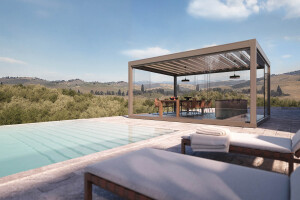A Living Space Designed Around Music
Initially conceived as a recording studio, the project evolved into a more comprehensive spatial program as architects reinterpreted its potential. Unlike a conventional recording studio, the design aimed to create a hybrid space that not only facilitates music production but also fosters social interaction and interdisciplinary engagement. With the architects' vision and the client’s support, the studio transformed into an organic platform centered around music, seamlessly integrating professional interactions, creativity, and social exchange. Beyond its function as a recording studio, Ring also holds the potential to serve as a hub for alternative cultural movements, providing a flexible environment for independent artists and collectives to engage, produce, and collaborate.

Urban Context and Spatial Transformation
Situated on Cinnah Street in Ankara, the project occupies the ground floor of a 1980s-built structure. The space had previously housed various businesses, and prior to renovation, it was stripped down to its bare shell. The redesign process was driven by the need to balance technical requirements with a strong architectural identity, ensuring that the studio and communal areas coexisted harmoniously.
The infrastructure underwent a complete overhaul, including the installation of a new electrical system, which replaced the existing but inadequate setup, and the integration of a fully functional heating system, which had previously been absent. Given the lack of insulation, an internal thermal barrier was introduced alongside a new radiator system to regulate indoor climate conditions. To enhance acoustic and thermal performance, all windows—except for the storefront glazing—were replaced.
The programmatic organization was defined by a clear separation of functions: the ground level, extending across different floor elevations, was designed as a coworking space, event venue, and café, while the upper floor was dedicated to the core function of the project—the recording studio and control room.


Recording Studio and Acoustic Design
The recording studio (live room) and control room were meticulously designed to meet acoustic and technical performance standards. Using the "room-within-a-room" principle, the studio was constructed as an isolated acoustic volume, minimizing sound transmission and ensuring that activities on the upper and lower levels could take place simultaneously without disruption.
To optimize acoustics, structural interventions were minimized, and tailored solutions were developed for both room and building acoustics. The live recording space, known as the “Birch Box,” was conceived as an independent unit, distinct in both materiality and spatial experience. Fully clad in birch, the room was designed to achieve a well-balanced acoustic response. In response to space constraints, a steel framework was introduced to expand the control room, extending the floor slab by approximately 40–50 cm. The upper floor was thus transformed into a fully optimized professional recording environment, where architectural design and technical precision converge.


Spatial Organization and Event Dynamics
Designed as more than just a recording studio, Ring functions as a social hub, fostering creative engagement beyond its core purpose. On non-event days, the space operates as a fluid social environment, rather than a conventional café or coworking facility. The service counter, deliberately positioned a few steps below the entrance level, creates a subtle sense of separation and a more intimate user experience. The stage area, strategically placed to the left of the entrance, serves as a defining spatial element, reinforcing the identity of the venue. A carefully arranged composition of seating, performance, and work areas facilitates unrestricted movement and organic social interaction.
As a visually dominant feature, both internally and externally, the stage is designed to accommodate a broad range of performances and events. From small-scale acoustic concerts and DJ sets to piano recitals, quartet performances, film screenings, seminars, and workshops, the venue offers a flexible cultural platform.
Beyond its architectural and acoustic identity, Ring contributes to the city’s alternative cultural landscape, offering independent artists and creatives a space for experimentation, collaboration, and community building.


Material Palette and Sensory Experience
The material and color palette was meticulously curated to establish a cohesive spatial atmosphere, ensuring a seamless connection between the recording studio and communal areas. Deep ocean blue, vibrant sunset red, burnt orange, and light smoke gray tones are juxtaposed with oak surfaces and custom-designed furniture, creating a harmonious blend of textures and colors. This deliberate selection integrates technical and social components, reinforcing the project’s multifunctional identity.


A Multi-Layered Experience
More than just a professional recording studio, Ring Music Studio & Living Room was designed as a multi-layered social space that fosters creative interactions and cultural exchange. While its technical infrastructure meets the highest standards for professional music production, its flexible programming structure encourages interdisciplinary collaboration. As a result, Ring positions itself as an innovative and dynamic venue, at the intersection of music, art, and alternative urban culture.





































